6 cars that flopped outside their home markets
2023 marks 50 years since the lovely Volvo P1800 ended production. Oddly enough, two other cars in this list exited stage left in 1973: The Sunbeam Minx and the Opel GT. This article originally ran in 2019 but, given those coincidences, we couldn’t resist sharing it again. —Ed.
The iconic WWII Willys Jeep and its later English rival, the Land Rover, have been sold around the world for almost 80 years. They make sense pretty much everywhere.
However, some cars just don’t translate to other countries, even if they were hugely successful where they were born. These include the tiny 1948–1990 two-cylinder Citroën 2CV and the 1959–2000 British Motor Corporation Mini. Based on their domestic reputations, each sold more than five million copies in 40 years. Overseas, they appeal to contrarians, who don’t care that they are small and slow.
Cross-cultural efforts have produced an endless list of unsuccessful transplants. Whether the brand name is changed or not, they just don’t fit, and some of the more bizarre attempts have been quite recent. Even if the cars were mechanically sound, a lack of parts and weak service support outside their domestic markets often proved insurmountable. Here are 6 such cases where cars in other markets got lost in translation.
1963–73 Sunbeam Minx and Arrow, Plymouth Cricket, Simca 1000

Chrysler leaped into the European market in 1964 and immediately wondered which vehicles from its overseas catalog could transfer to the United States. The Shelby Cobra–like Sunbeam Tiger was the fastest option, packing a V-8 stuffed into an Alpine roadster. But Chrysler didn’t have a suitable substitute for Ford’s lightweight 260-/289-cubic-inch engine found in the Cobra, so the Tiger died off in 1967.
Moving downmarket, Chrysler branded British four-cylinder Hillman Minx and Hunter sedans as Sunbeams. The Hunter sold almost 500,000 examples worldwide in 10 years, but only a handful reached the U.S. in 1967, badged as Sunbeam Arrows. The underpowered Minx sedan was imported in 1966–67, with the option of a pathetic automatic transmission. French Simca 1000-cc sedans dribbled into the states from 1963–69, but few survive, despite 1.6 million sales elsewhere. Hillman Avenger sedans and wagons arrived in 1971 as Plymouth Crickets to fight the Pinto and Vega, but the European models had little support. Only 27,682 Crickets were sold in three years, and by Jiminy, it’s virtually extinct today.
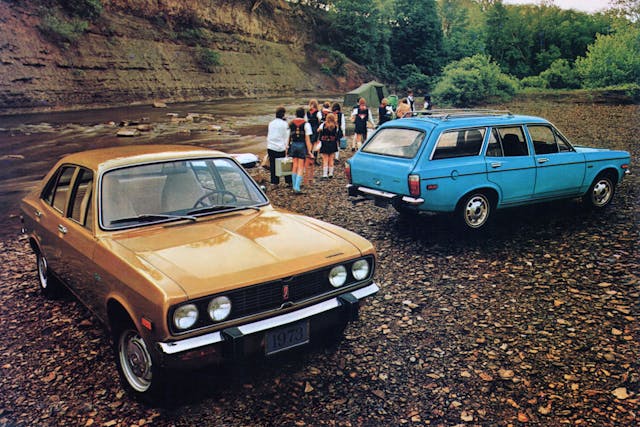
In a curious turn of fortunes, Chrysler was successful with Mitsubishi imports in the 1970s. It sold more than 300,000 Dodge Colts, Challengers (!), Plymouth Champs, Arrows, and Sapporos while developing its own Chrysler Le Baron, Plymouth Reliant, and Dodge Aries K-cars. Few 1970s captive imports survive and 1980s K-cars are scarce, though no one cares.
1991 Lotus Elan M100

Sturdy if bland, the Lotus Elan M100 was reputedly penned by a Japanese team competing for the design of the Mazda Miata. Unfortunately, the team lost the bid to Japanese expat Tom Matano, who spent years working for GM before moving to Mazda’s North American arm.
The Elan offered a 165-hp, 1588-cc, turbocharged DOHC fuel-injected Isuzu four-cylinder engine, which drove the front wheels via a five-speed manual gearbox. The car weighed 2249 pounds and was capable of 135 mph. While it was quick and handled well, front-wheel drive was anathema to Lotus fans; in 1991, only 528 were sold in the U.S., at an uncompetitive MSRP of $33,900. Worldwide production totaled only 3855.
1975–76 Chevrolet Cosworth Vega
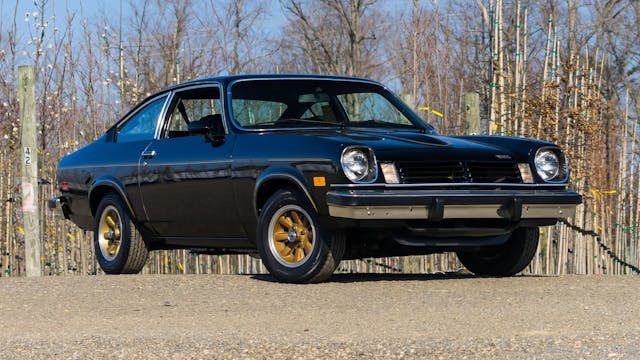
When the Chevrolet Vega was launched in 1971, John Z. DeLorean demanded a twin-cam version aimed at the BMW 2002 and the Alfa Romeo GTA, both of which competed in SCCA and in various European circuits. Keith Duckworth of Cosworth Engineering designed a DOHC engine, 1000 of which were required for homologation. Cosworth’s engine developed 290 hp at 9000 rpm, but the high-silicon alloy blocks kept breaking, and Duckworth quit.
Cosworth’s Weber DCOE carburetors could not be smogged, so the four-cylinder was fitted with Bendix fuel injection and its crankcase reinforced for 1974. But emissions demanded 8.5:1 compression instead of the planned 12:1 ratio. Horsepower plunged to a miserable 110 hp. Then the motor failed EPA testing and the project was delayed until 1975.
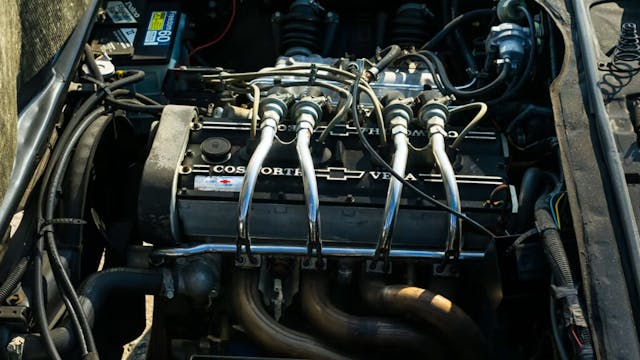
All 1975 Cosworth Vegas were black with gold trim, but cost $5916—double the cost of a standard Vega. Each CosVeg had a four-speed gearbox, unique alloy wheels, full instruments in a gold-tinted dashboard made of turned aluminum, and a numbered dash plaque. 1976 Cosworths came in seven other colors: Antique White, Dark Blue Metallic, Firethorn Metallic, Mahogany Metallic, Dark Green Metallic, Buckskin, Medium Orange, and Medium Saddle Metallic. A five-speed manual was optional.
The muscular price tag and minimal performance meant that only 2061 Cosworths were built in 1975 and 1447 in 1976. Of 1492 leftover engines, a few were used for warranty, 500 disassembled for parts, and the rest scrapped for a tax write-off. Ironically, present-day engine technology can deliver on Cosworth’s original promise.
1970–73 Opel GT
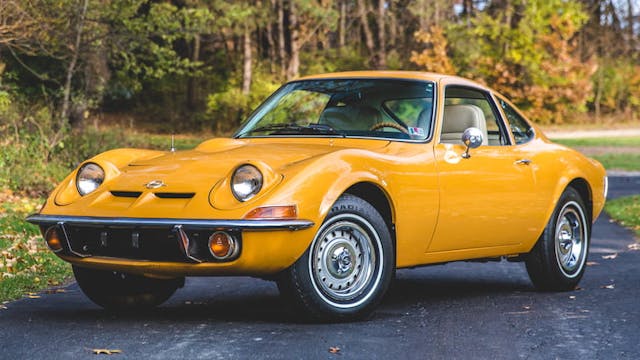
When the Opel GT concept was shown at the 1965 Frankfurt and Paris Motor Shows, it was hailed in Europe as a mini Corvette and reputedly delayed until the strikingly similar C3 Corvette was ready. The GT’s running gear came from the lowly Kadett, but the elegant bodies were built by Brissonneau and Lotz in Paris and shipped to Germany for assembly. Most had a 90-hp, 1897-cc, “high-cam” (almost-OHC) engine. In all, 103,373 GTs were built. About 70,000 were sold in the U.S. by puzzled Buick dealers grateful for an automatic option.
The GT’s layout was intricate. Front suspension was by transverse-leaf with a live rear axle located by coil springs, trailing arms, and Panhard rod. Brakes were disc/drum and steering rack-and-pinion. Hidden headlights were manual and flipped over sideways. There were four round taillights but no opening trunk, for structural rigidity. Road & Track reported 0-to-60 mph in 10.8 seconds, but wind-tunnel research and ram-air induction enabled a top speed of 115 mph.
Bash-bumper laws of 1974 doomed the GT, which suffered chronic rust issues. The 1.9-liter engine had a tiny three-quart sump, so oil levels had to be checked regularly. Those flip-over headlights demanded flexible wiring, but engine heat hardened the harnesses’ plastic insulation, which cracked and led to fires. With so many built by Opel, spares do exist; even better, wrecking yards and hoarders rarely crush these cars.
Volvo P1800 and Jensen
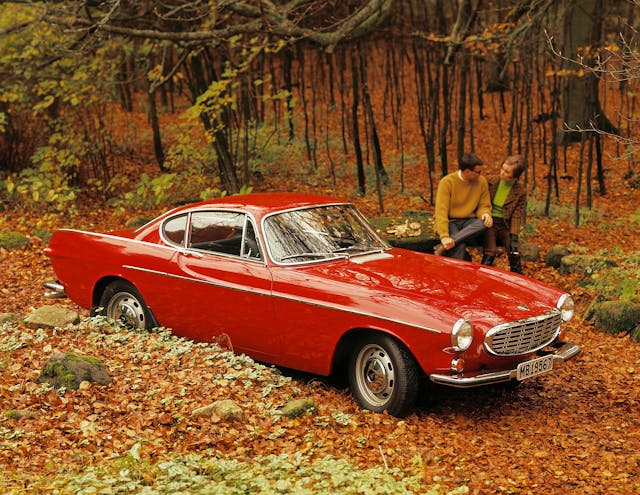
Volvo’s first sports car was the disastrous P1900 roadster in 1955. A fiberglass blob with a pig snout, one tester listed 29 “must fix” problems. Volvo’s CEO Gunnar Engellau took the P1900 on a 447-mile trip and canceled it on his return. Only 68 examples had been sold.
The 1961 P1800 sports coupe was much better. Derived from Virgil Exner Jr.’s Chrysler concepts built by Ghia in the 1950s, the design resembled Ghia’s Thomas Special and Volkswagen’s Karmann Ghia coupe: It wore fins, a curved side spear, and “cow horn” front bumpers. A kitschy interior featured chrome and stylized gauges.
With its factories already running at capacity, Volvo contracted with UK-based Jensen to build the first 6000 examples of the P1800. However, chronic rust issues in the unibodies of the Jensen-built cars forced Volvo to return production to Sweden in 1964. Now called the 1800S, the car’s grille was simplified and its bumper straightened. The curved front bumpers and side spear vanished the next year.
The 1800 was saved from obscurity by actor Roger Moore, who drove one in the seven-year British TV series The Saint. The network wanted a Jaguar E-Type, but Sir William Lyons refused. Volvo’s 1800 proved mechanically bulletproof, with a 1.8-liter B18, four-cylinder, OHV engine, front disc and rear drum brakes, independent front suspension, and vault-like unit construction. Production lasted until 1973. Retired teacher Irv Gordon drove his 1966 model 3,250,257 miles.
Saab 9-2X, 9-7X, 9-6
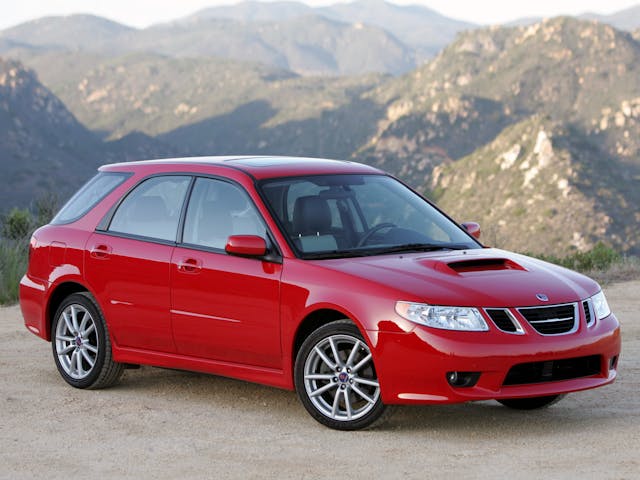
Considering Saab was such a well-defined brand, it’s amazing how many bizarre, rebadged vehicles have carried the name since the egg-shaped 92 was launched in 1950. Never mind the Triumph engine in the 1967 Saab 99; the Saab 600 of 1978 was really a Lancia Delta, while the 9000 of 1985 shared mechanicals with Alfa Romeo 164, Fiat Croma, and Lancia Thema. GM bought 50 percent of Saab in 1989 for $600 million and that resulted in the Opel-based 900 of 1994. Both the 900 and 9000 were renamed in 1997 as the 9-3 and 9-5.
When GM bought the remaining 50 percent of Saab in 2000 for $125 million, it cast around for other ways to monetize the brand. Since GM owned 20 percent of Subaru (Fuji Heavy Industries), an obvious choice was the all-wheel drive, turbocharged WRX Impreza wagon. The five-door Subie was face-lifted forward of the windshield, weighed down with luxury options, improved in numerous mechanical aspects, and saddled with a price tag $3000 higher than the Subaru’s. Launched in 2004, the 9-2X’s best year was 2005, when 5940 were sold. That figure faded to three in 2008. The total count: 9284.
The Saab 9-7X was an expensive Saab variation of the Chevrolet Trailblazer, designed to replace the Oldsmobile Bravada. It debuted in 2005 and managed to catch a bit of the SUV wave, selling 85,994 units before succumbing in the 2008 crash, with 1209 leftovers sold in 2009. Mercifully, perhaps, plans to sell a Saab-badged variation of Subaru’s unpopular Tribeca SUV (badged as the 9-6) were shelved when GM sold its share in Fuji Heavy Industries in 2005. The 9-6 plan was never officially revealed until a prototype was added to the Saab museum in Trollhattan in 2011.
***
Check out the Hagerty Media homepage so you don’t miss a single story, or better yet, bookmark it. To get our best stories delivered right to your inbox, subscribe to our newsletters.
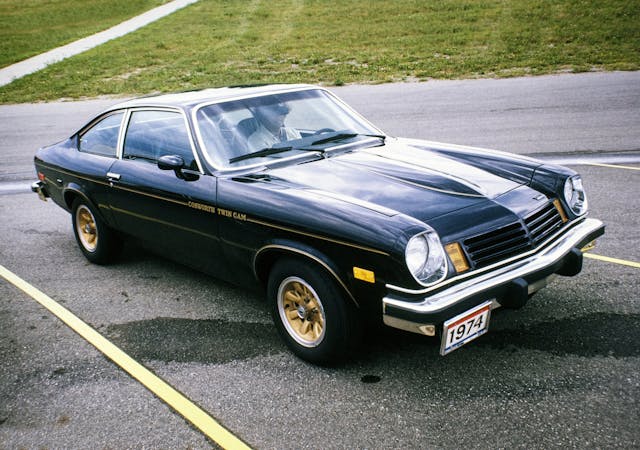
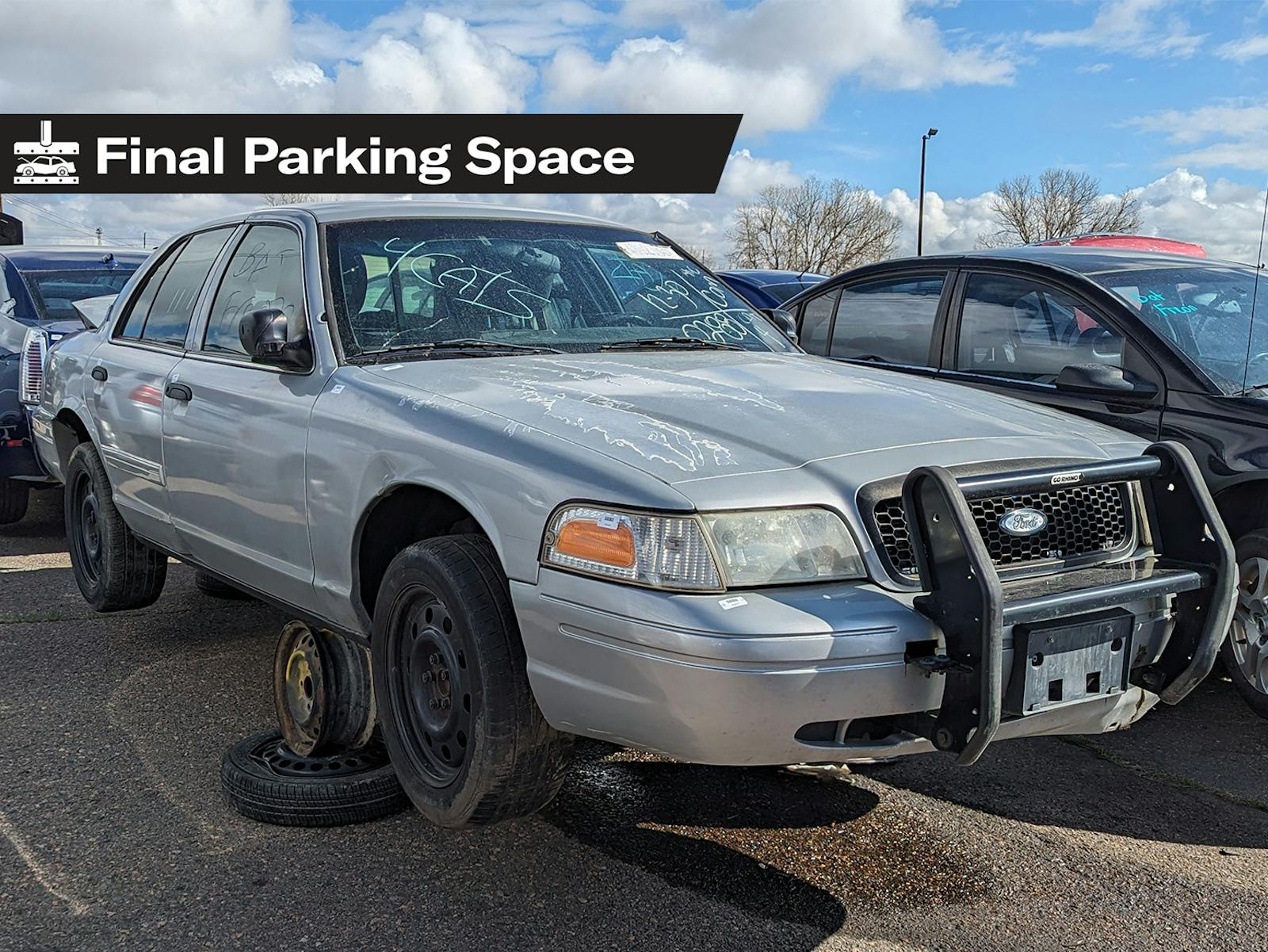
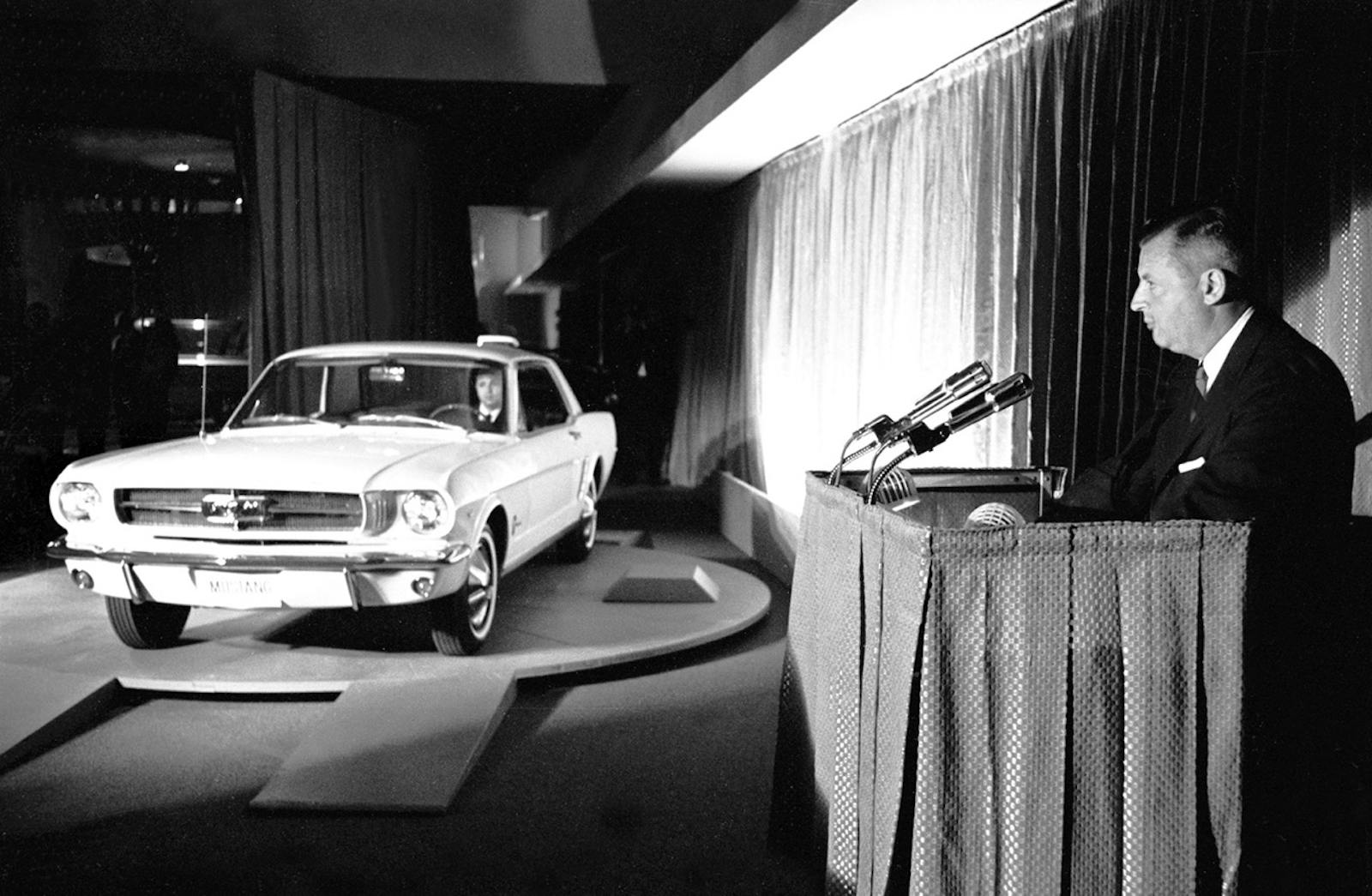
All of the things that make little European cars interesting are usually the things that do not meet US emissions or safety standards. The somewhat bland taste of the average US car buyer generally takes care of the rest.
All of these cars flopped everyplace.
Agreed, except the Mini and 2CV none of them sold well anywhere. The title of the article is pretty much unrelated to the content.
Except, of course, the ones that were successful, as pointed out in the article. 🙂
Honda should build a new correct Opel GT…non frills sports car only……..5sp/clutch, V-6, Leather, amped radio, it would sale for 1/2 a Vette and fill dealer showrooms w/floor traffic…….
Correct you are sir! What a car that would be. Let’s get back to the simple sport car ( Carrol Shelby’s term) hopefully create another generation of gear heads.
Unfortunately it’s impossible to build a “simple” car today. FMVSS rules add $thousands to the cost of a vehicle and take away many designers artistic license. The lovely Miata is approaching $35k which is still a bargain but if you had to design a similar fun vehicle from scratch and amortize the development costs it’s a non starter.
That ship has sailed.
The Opel GT should be built by BUICK
Why?
Buick doesn’t even build Buicks anymore.
Buick doesn’t even sell sedans.
They will be a China only brand in less than 5 years.
GM will never recover from this mess.
It was never built by Buick. It was built by a German firm named Opel, which was owned by GM until 2017. The GT and Mantas were sold by Buick, but not built by the company.
Opel used to be (and may still be) more highly regarded in Germany than either BMW or Mercedes.
The Vega was a good car if you treated her good!
Good car; not really. Grandfather bought three, one for each of kids as a Christmas present one year. Also immediately our’s needed a new engine. Then another needed a new engine; however to be honest after that all three lasted I our families until were driven in to the ground, well rusted. I must admit there is part of me that wanted a Cossie, properly modded!
I owed 2 Vegas and loved them both, especially my 1977. I always had people commenting on it.
I think the best Vegas are like my neighbor/car buddy has. It has a tube frame, built 350 Chevy & a 4 speed! Just seems like a natural setup for a Vega!
I was in the Air Force in Dover Delaware, and it was a Chevrolet dealer in the town just north, I went there and took it for a test drive, I was impressed. Glad I didn’t buy it cause I saw them rust away as time went on up here in the Northeast.
I had a 1970 wagon and it was a fun car and served me well. I later had a 72 and I sleeved the engine and it gave me good service. I later got ahold of another 72 and dropped a 283 in it -that was fun. I would love to find one now that wasn’t rusted out as I loved the look of the car.
Agreed, we owned three of them two new and one used and all held up well as long as they weren’t abused. Only issues was a bit cramped for my 6’1″ frame.
I always thought the Vega was a really neat looking car. Unfortunately, rust and a stupid engine killed it. It is amazing how a company as large as GM could make such stupid mistakes. Of course they made many other like the Pontiac Aztec.
Terrible car because of the engine. Back in 1974 a friend of mine worked for a large Chevy dealership and at any time there was at least ten Vegas in for engine replacement. One car I remember was in for it’s third engine. The cast iron exhaust manifold would crack in several places and fall apart.
Yes, the Vega was a pretty decent car that was introduced as Chevrolet’s entry in the compact car fight (following the demise of the Corvair.) The first 2 years of the Vega were fraught with problems, starting with the cylinder walls that scored easily due to a manufacturing defect. Chevrolet would sleeve the cylinders for owners under warranty. The early Vegas were also prone to rusting, a problem that was pretty much resolved with the new H-Body style in 1974.
The Cosworth Vega project was revived to rehabilitate the Vega’s image, but it fell victim to the oil embargo of 1973 and the subsequent emissions requirements that neutered the potent 2-litre engine. Some of the lost power could be regained by swapping out the Bendix EFI and bolting up a pair of Weber DCOE side-draft carbs. A bit more hp could be gained by removing the CAT (illegal!) and replacing the muffler with a higher-flow version. It was a pretty decent autocross setup!
But you need to keep the context of why each failed.
Sunbeam and Cricket were crap cars.
The Opel and the Volvo both did well for a low volume sports car. They were never going to be big volume cars as only a Corvette with two seats sells in volume.
The Lotus failed as it was wrong wheel drive. If it has RWD it would have worked.
The Vega was just way over priced and not that powerful.
The Saab failed because it was not a Saab. Most would just buy the WRX or they would buy a real Saab not a rebadged Saab.
As for the original Mini and 2CV neither sold in high volume here as they were just small for the mini a the time and the 2CV was not much more than a cheap car that did well in a decimated post war Europe. In America it was a crap car. It was the Yugo of its time.
The 1970 Opel GT sold over 21000 units in the US in 1970, versus roughly 17600 Corvettes and just over 16000 Datsun 240Zs. The Opel GT was actually a sought-after car in 1970. After that-not so much.
I was 21 and selling Plymouth Dodge and Chrysler and when the Kricket came out. What a little hunk of junk. Cheap as you can get seats, trim and nothing engine. Couldn’t give them away. Chrysler Corp was on the ropes and these little junky cars were part of the reason why!
I bought a used Plymouth Cricket with about 5k mikes on it for $500 in 1978 while in university. The dealer couldn’t wait to take my money. I put 75k on it including driving it from Toronto to the Rockies and back for summer jobs. I taught a girlfriend how to drive stick and we got a pretty good laugh (it’s a cricket, not a rabbit) every time she let out the clutch too fast and it shuddered since it didn’t have enough power to do much else.
Wasn’t the M100 Elan styled by Peter Stevens (also of McLaren F1 fame)
The M100 section is an example of how misinformation is spread. Usually trustworthy sources echoing unattributed rumors.
As noted in these comments, the M100 styling was done by Peter Stevens.
In addition to coming out at the same time and being twice as expensive as the Miata, it was also confused with the Mazda 323-based Mercury Capri convertible. And the start of sales coincided with a recession.
On the Opel GT, in many ways, it was a cool car that was ahead of it’s time. Sporty and fuel efficient. But it was not a true sports car. Among other things, the Opel GT fell victim to the fantastic Datsun 240Z which also had a hand in killing off the Triumph GT6.
The 240Z had two things going for it that the Opel could not overcome: rear seats and a rear hatch.
The 240Z never had a rear seat, at least not in the US.
240Z never had rear seats.
Where did you see one of these with a rear seat?
I remember the Z with rear seats but I think it was the 280z or maybe even the 260z. Might have been the 2+2 model?
I use to work on a lot of Zs all through the 80s but it’s been so long it’s hard to member and I’m too lazy to research it.
It was the 280zx that was the 2+2. My Mother had one…you could hardly fit a hatbox in that rear seat.
Yes, the 1974 260Z was the first to be offered as a 2+2 version alongside the original 2-seat version. The 280Z also starting in 1975. The 240Z never was sold in the US as a 2+2.
Did you mean 240SX?
240 SX did not have rear seats
Yes it did. My brother bought a 1989 240 SX new. It had rear seats. Look it up. 240Z was never sold in the US with rear seats.
You can see the rear seats of a 1989 240 SX right here.
https://bringatrailer.com/listing/1989-nissan-240sx-26/
Thank you.
Actualy in Car & Driver test July 1970 they were pretty close. I owned both & still have a 73 Opel GT. The 240 was quicker but the beauty of the GT was/is the weight distrbution at very near 50/50 the handling is amazing. Should have had a turbo 6 in it (IMHO). I’m lightly modified orginial 1900 4 in mine now. Mild cam, hi-comp pistons, & Weber fuel delivery, inproved suspension, 15″ wide tires, ect. Handles like a go cart. I had all the z cars 240-300 and they were all a bit heavey in the front end.
If you put a turbo 6 in it, that Opel will also be a bit heavy in the front end.
The best thing about an Opel GT was the space in front of the radiator where the air came in through the front splash pan. There was just enough room in there to hide 2 or 3 six-packs of beer, and as long as you kept moving, they would stay cool all day!
Not a single surprise!
The Volvo P1800 was not “derived from Virgil Exner Jr.’s Chrysler concepts built by Ghia.” It was penned by Swede Pelle Petterson while working for the Pietro Frua design house. For many years it was assumed to be an Italian design, largely because Volvo didn’t want to admit that its creator was the son of Volvo Exec Helmer Petterson. Early production issues aside, the car was anything but a flop, with 1800 variants produced through 1973.
The P1800 was not a flop. It was a good car. It deserves mention of Irv Gordon who put 3,000 000 miles on his!
Yea, I was puzzled to see the P1800 on this list as well. Lumping it in with obvious losers, like the Plymouth Cricket and Chevy Vega, seems harsh. OK, the early, Jensen-built cars were rust-prone (and probably had quality issues) but Volvo stepped up to address that. A fair number of P1800’s were sold and they were certainly more durable than the other models profiled in this article.
@hyperv6; Except the original Mini in the UK.
I am surprised the Saab Sonett wasn’t on the list. I had a ‘69 V4, #000686, which I bought in 1971. They were very rare. Even today only the Sonett III is traded very often on sites like Bring A Trailer. The V4 was downright ugly, but I enjoyed driving it. It was a killer on autocrosses, too.
This piece must have been sitting in your “To Run Eventually” file for quite some time, as my buddy Paul passed away last year.
Silver lining is one less source of poorly researched/written clickbait.
As admitted at the top of the article it originally ran in 2019.
My eldest brother bought a new Dodge Colt 2 door back in 1972 and it was a decent runabout in the day. The Vega and Pinto were inferior if that was any consolation. Most cars in that time period seemingly lost their luster. In my opinion, the automotive industry lost its way, grasping at virtually any design to keep profits coming in, and the factory floors from laying off workers. Government mandates for safety and emissions were long overdue and engineers hadn’t much time to come up with better solutions to meet the regulations. In the end, all seemingly worked out for the best.
In the 70’s I worked for Ford before opening my own shop which I still have. I don’t know why people have a bad view of the Pinto. We used to call the 2000cc motor the Buzz Bomb. It was a German design and no matter how you revved it the motor wouldn’t explode. The 2.3 engine became a bread and butter engine that Ford used in almost every small and midsize cars and trucks they made up to the mid nineties. It was a great running motor that handled an automatic easily. By the way I never saw or heard of a Pinto exploding in all my years at Ford.
Lots of Pintos lived a second life as short-track oval race cars. The engines were powerful and the cars proved remarkably durable.
Good point. There were 27 verified deaths resulting from rear end collisions, the same number as attributed to Pinto transmission failures. The total production of Pintos was nearly 3, 200, 000 units. This was a non-story made into news by a press eager to inflame (no pun intended) public opinion.
I had a “76 Vega Estate Wagon back in the late 70’s; never a problem and a fun drive.
The Pintos with the gas tank issue were the hatchback model.
No, I believe the Pinto that had the fire issue were the trunk-style models. They only offered them the first few years of production, all the rest were hatchbacks and wagons.
I agree. My mom had a ’74 wagon that ran like a top. 30 mpg was normal & never a problem. I drove the car some on visits after I got out of the USMC & thought it was a great road or city car
I had a Pinto with the 2000 engine it the early 1980s -don’t remember the year. I put headers on it and changed the carburation. It had good response and was fun to drive.
I had a special edition Boss 2000 Pinto with the 2000 engine and a small Holley 4bbl I used to go looking for Vegas to embarass!
In the “end” Japan kicked everyone’s butt.
My 1973 Dodge(Mitsubishi) Colt was overhead cam, hemi head and ran well. Got me thru college, but the rust worm bored into it big time. Later owned another Mitsubishi product, a 2000 Montero. Both good vehicles.
I always liked the early-70’s Colt two-door hardtop model. As you say, the hemi-head OHC engine was noted to be quite quick for a small car, especially with the 4-speed.
And I forgot about my 1987 Mitsubishi Mighty Max pickup, later rebadged as Dodge Ram. Also a good vehicle.
Vega and Opel didn’t thrive ANYWHERE.
Opel was for years the best selling brand in several European countries.
A high school guy in my neighborhood got a new 71 Vega. The engine died within 3000 miles. My parents had the Opal Kadet Wagon which had it’s own problems. Any right turn was subject to the engine stalling out. The dealer couldn’t fix it, but my older brother did. He took it to Salton Sea camping one weekend and rolled it in the desert. But my dad’s 71 Pinto was a work horse. He drove it for a year, gave it to me for a couple of years then my sister had it for several more. It finally went to a friend of my brother who was the last owner of any car he had.
I had a ’72 Dodge Colt, 4 speed, put 15″ inch chrome slot wheels on adaptors and had a ball driving it until a divorce forced it’s sale. Wish I could find another that isn’t worn out.
You know it’s time to give up and move on when you lose a 72 Dodge Colt in a Divorce 🙂
Any divorce is time to move on.
I like that first Colt a lot, but what you say is pretty funny!
“Wish I could find another that isn’t worn out.”………What, the car or the wife?
Regarding the Sunbeam Tiger, I once read Chrysler wanted a platform for their 273 V8 but didn’t realize Ford had a contract to put their 260 then 289 engines in the Tiger. In negotiations for the take over, Chrysler committed to put their 5yr/50,000 mile warranty on Sunbeams. So until they killed it, the 289 stayed and Chrysler had to warranty the Ford driveline 5yr/50,000 miles. Don’t know how much truth is in that story but makes sense.
I worked for Chrysler at the time and it is definitely true. In fact, Chrysler’s 5 year, 50,000 mi warranty was better than what Ford was offering.
You are correct about Chrysler having the 5yr/50,000 mile warranty on the ford driveline in Tigers. My business sold Tigers and it was always a bit of a ribbing point from customers, but also the engine Chrysler wished to use in the Tiger could not be configured into the body easily because it had bulkier dimensions, so , reluctantly, they had to stick with the 260/289 .
Was the Simca sold in the US? San Diego was flush with them. I thought Servicemen brought them home from overseas.
They were available in Plymouth dealership, at least in my hometown. (Traverse City, MI). FWIW, two high school kids could clean and jerk the front end of a Simca with ease.
I had a simca. Sold through Chrysler. Blew head gaskets so fast with their blue flash engine. I could replace it in a couple of hours.